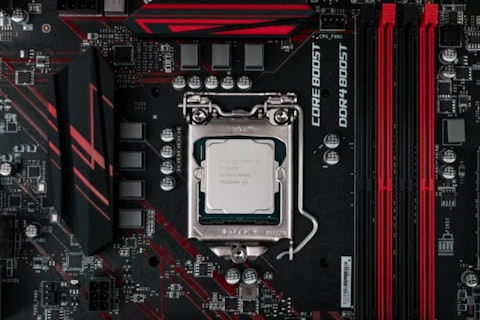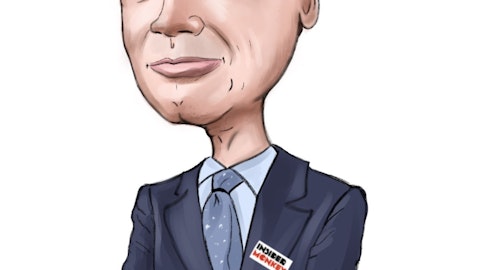Onto Innovation Inc. (NYSE:ONTO) Q2 2023 Earnings Call Transcript August 10, 2023
Onto Innovation Inc. misses on earnings expectations. Reported EPS is $0.79 EPS, expectations were $0.83.
Operator: Good day and welcome to the Onto Innovation First Quarter Earnings Release Conference Call. Today’s conference is being recorded. At this time, I’d like to turn the conference over to Mike Sheaffer, Investor Relations. Please go ahead.
Mike Sheaffer: Thank you, Cynthia. And good afternoon, everyone. Onto Innovation issued its 2023 second quarter financial results this afternoon shortly after the market closed. If you did not receive a copy of the release, please refer to the company’s website where a copy of the release is posted. Joining us on the call today are Michael Plisinski, Chief Executive Officer, and Mark Slicer, Chief Financial Officer. I would like to remind you that the statements made by the management on this call will contain forward-looking statements within the meaning of the federal securities laws. Such statements are subject to a range of changes, risks and uncertainties that can cause actual results to vary materially. For more information regarding the risk factors that may impact Onto Innovation’s results, I would encourage you to review our earnings release and our SEC filings.
Onto Innovation does not undertake the obligation to update these forward-looking statements in light of new information or future events. Today’s discussion of our financial results will be presented on a non-GAAP financial basis, unless we specify otherwise. As a reminder, a detailed reconciliation between GAAP and non-GAAP results can be found in today’s earnings release. I will now go ahead and turn the call over to our CEO, Mike Plisinski. Mike?
Michael Plisinski: Thank you, Mike. Good afternoon, everyone. And thank you for joining our call today. I’ll begin with shipment timing of shipments for three lithography tools which impacted our second quarter results and third quarter guidance. All three tools were for a specific customer and scheduled to ship near the end of the second quarter. During the quarter, we accepted a customer request for specific enhancement package to be added to the tools in manufacturing. We estimated this could be installed and tested in the quarter, but ultimately the full verification took longer than planned. The customer has since approved this new functionality and the tools are included in our outlook for the third quarter. In aggregate, the second quarter revenue and third quarter outlook remains consistent with our prior guidance of just over $400 million for the sum of those two quarters.
This reflects the weak demand from our advanced nodes customers, being offset by strong power semiconductor revenue and the more recent resurging demand for our Dragonfly inspection systems to support heterogeneous packaging and high bandwidth memory customers. In fact, we expect this specific demand to drive more than $90 million in revenue over the next three quarters. I’ll provide additional details about our outlook in a few minutes, but first let’s dig a little deeper into the second quarter. We’ll start with our specialty and advanced packaging customers where revenue from this customer group grew by over 20% from the prior quarter. Revenue from our power device customers grew over 35% and included our product portfolio of inspection metrology and software solutions.
This was our largest market in the quarter and, in fact, revenue exceeded total power device revenue in all of 2021. Building on this demand, in the quarter we announced the intent to expand our metrology portfolio with the release of Element S material metrology and Atlas S OCD metrology, each specifically designed to address challenges in the compound semiconductor manufacturing. We’ve already secured orders for these tools and shipments will begin in the fourth quarter. With these additional products, we believe we are positioned to address an estimated 80% of process control steps in this high growth market, which is estimated to require 10 times the current volume of wafers by 2030. In advanced packaging, we delivered over $20 million of inspection systems to customers ramping heterogeneous packaging lines to support growing end market demand for high performance compute.
The flexibility of our Dragonfly systems switch integrates sub-micron 2D defect detection 3D metrology and our unique Clearfind capability into a single system is proving to be a powerful tool for the heterogeneous packaging applications used in high performance compute. For example, Clearfind technology is able to detect residue on die to die or die to substrate interconnects and ensures good die bonding, while our 3D metrology sensors provide critical stack height information and coplanarity data for the package. This metrology is proving essential to controlling yields and is leading to higher attach rates. In sharp contrast, revenue from our advanced nodes customers declined 43% in the quarter. However, even as capacity buys wane, R&D investments have continued.
And in the second quarter, we were pleased to see further proliferation of Iris films when it was successfully qualified by a top 3 DRAM manufacturer in the quarter. In addition, we delivered several Atlas OCD systems to two customers for gate-all-around applications. We believe that declines in advanced nodes will reach a bottom in the third quarter, with strong demand in specialty and advanced packaging continuing in the second half of the year. Before moving to our outlook for the third quarter, Mark will now cover the financial results for the second quarter.
Mark Slicer : Thanks, Mike. And good afternoon everyone. As Mike highlighted, we closed the second quarter with revenue of $191 million, down 26% over the same period last year, and below the second quarter guidance range of $195 million to 203 million due to the shift in timing of the three JetStep systems Mike commented on. Despite the lower revenue, we did achieve an EPS of $0.79 for the second quarter, within our EPS guidance range of $0.75 to $0.90. The revenue decline from the same period last year is primarily due to the decline in our advanced nodes business, which had revenue of $38 million and represents 20% of revenue. Specialty device and advanced packaging revenue of $112 million represents 69% of revenue and software and services had revenue of $41 million, which represents 21% of revenue.

Photo by Christian Wiediger on Unsplash
We achieved 53% gross margin for the second quarter, exceeding our guidance range of 50 to 52%, driven by the favorable mix, shipping fewer JetStep systems and seeing an initial favorability due to our supply chain optimization efforts. Second quarter operating expenses were $59.9 million, within our guidance range of $58 million to $60 million. We are still executing to our cost reduction activities. However, we have continued to maintain a slightly higher level of investment in R&D initiatives, as Mike mentioned, aligning to R&D engagements in planar films and power semiconductor applications. Our operating income of $41 million was 21% of revenue for the second quarter, compared to 29% from the prior year. Our net income in the second quarter was $39 million or $0.79 per share.
Now moving to the balance sheet, we ended the second quarter with cash and short term investments of $610 million, an increase of $62 million from the start of the year, with operating cash flow of $31 million within the quarter, representing 17% of revenue for Q2. Inventory ended the quarter at $352 million, an increase of $14 million. We continue to actively manage down our inventory levels across the network. However, we had increases in lithography and services inventory within the quarter. We are projecting a decline in Q3 and are now targeting to be between $275 million and $300 million by the end of the year. Accounts receivable decreased $22 million to $188 million in the quarter, and our days sales outstanding decreased 6 days to 90 days.
With our inventory reduction goals and focus on cash collections, we expect to return cash flow to consistent performance of over 20%. During the quarter, we did not execute any share repurchases. We have $32 million remaining under our existing $100 million authorization. Now turning to outlook for Q3, we currently expect revenue for the third quarter to be between $205 million and $225 million. We expect gross margins will be between 50% to 51%, primarily due to lower advanced nodes revenue, which typically carries higher margins above our corporate average, as well as the shift of the JetStep systems built in Q2 now shipping in Q3. For operating expenses, we expect to be between $57 million to $59 million. For the full year 2023, we expect our effective tax rate to be between 14% to 16%.
We expect our diluted share count for Q3 to be approximately 49.4 million shares. Based upon these assumptions, we anticipate our non-GAAP earnings to be between $0.85 per share to $1.05 per share. We are making progress towards reducing our fixed cost structure by optimizing our supply chain and manufacturing sites, while maintaining our strategic priorities and several R&D programs and ensuring our ability to deliver financial performance in line with our long term operating model. The team has made significant progress to date, expanding our second shift to drive higher absorption of fixed costs, while improving cycle times and outsourcing several non-core sub-assemblies to global supply chain partners. We have set aggressive but achievable targets with our global partners, consolidating our supplier base by greater than 50% over the next two years, while also simplifying our key components, such as moving to a common automation system, which will drive a 25% cost reduction and as part of our identified savings for 2024 and 2025, as highlighted during our recent Analyst Day.
With that, I will turn it back to Mike for additional insights into Q3 and the remainder of 2023. Mike?
Michael Plisinski : Thank you, Mark. As Mark mentioned, we expect the third quarter to be up 18%, reflecting an increase in both process control and lithography revenue over the second quarter. Expected increase in process control revenue is mostly driven by capacity expansions and higher process control intensity to support heterogeneous integration of GPUs and high bandwidth memory. Combining these two powerful technologies into a single package is enabling customers like Nvidia to supply the specialized compute platforms to support the growing demand for large language model applications by hyperscalers and corporate enterprises. These assembly processes are more complex. And with multiple die becoming a single package, the impact to yield of a single interconnect failure is much higher.
The proven ability of our Dragonfly G3 system to reliably monitor for these failures is driving the projected increase in demand of over $90 million in revenue, which we mentioned earlier. We also project demand for our portfolio of products supporting power semiconductor customers to remain near current record levels. We still see headwinds in the advanced nodes, primarily from DRAM manufacturers, and we expect revenue to decline again in the third quarter, which we believe will mark a bottom for front end memory overall. We’re optimistic for a possible recovery in the second half next year as customers like Samsung are beginning to talk about the launch of new smartphones and PC promotions in the second half of 2023 being a catalyst for customer inventory reductions going into next year.
In summary, we see strong demand for our products to support power semiconductor device manufacturers and heterogeneous packaging in both wafer and panel substrates. In these markets, we believe our portfolio of connected solutions provides differentiated value, further contributing to the adoption rate we’re seeing. In the advanced nodes, though spending is down significantly this year, our customer collaborations are resulting in new tool of record positions for our Iris planar films metrology and integrated metrology, while progressing the capability of Atlas OCD metrology to new applications and more challenging transistor geometries. We expect these new product positions should lead to higher wallet share when investments resume in the advanced logic and memory markets.
At the same time, we’re implementing the structural improvements to operations and supply chains that should result in a stronger financial foundation as we close in 2023 and prepare for the new year. I’ll now turn the call over to Cynthia for questions from our covering analysts.
See also 30 Most Important Economies in the World and 20 Most Consumed Beer Brands in the World.
Q&A Session
Follow Onto Innovation Inc. (NASDAQ:ONTO)
Follow Onto Innovation Inc. (NASDAQ:ONTO)
Operator: [Operator Instructions]. And we will take our first question from Charles Shi with Needham.
Charles Shi: Mike and Mark, really just want to start out with some of the commentary around heterogeneous integration and high bandwidth memory. So on high bandwidth memory, can you kind of provide us a little bit further outlook beyond what you think the $90 million over the next three quarters? Do you think high bandwidth memory, the wafer starts is going to grow? In what kind of fashion? Is it like more linear as some other management team seems to believe or you think it’s going to be a much higher growth? Any indication from our customers on high bandwidth memory will be great. But then a related question really is about – very specifically about CoWoS. I know heterogeneous integration probably cover a lot of stuff, not just about CoWoS, but specifically on CoWoS, was how much opportunity you’re seeing today? Can you quantify for us?
Michael Plisinski: I’ll answer the last one first. Regarding CoWoS, when we talked about heterogeneous integration specific for AI, I think it’s pretty clear that, for instance, Nvidia who’s driving a lot of this is tied to TSMC and CoWoS. So that’s a fairly significant driver for us and for that $90 million that we mentioned. As far as HBM and the growth overall, what we’re seeing is a pretty rapid increase in demand right now. Part of it is capacity expansions. Part of it is, I think, a little bit of process control intensity increase. Certainly, that’s the case in the CoWoS area. So it’s hard to say how that rapid increase continues into 2024. We certainly expect additional orders in 2024. And we’re already having some of those discussions beyond the first quarter.
But is it going to continue on this rapid trajectory, this rapid growth trajectory? Or will it start to slow down, that’s going to remain to be seen and a lot will depend on how quickly, I believe, the enterprise customers adopt AI and these large language models for applications internally.
Charles Shi: Can I ask a second question. Maybe advance nodes, you said advanced notes, you believe it’s bottoming in Q3. Can you clarify a little bit more because advanced nodes for you guys is not just about memory, but also advance foundry logic. Between these two, I think you said memory is bottoming in Q3, but what about advanced foundry logic ? Can you clarify if I heard something wrong?
Michael Plisinski: I think what I was talking is, overall, we think the bottom is there primarily from DRAM, so DRAM has been the biggest drop. Advanced logic has been a little more stable. And we’ve seen that have less of a big impact on our advanced nodes trajectory. So we do think advanced notes – do we know if logic is going to snap back right away? No, but we do see several new fabs being built, everybody’s aware of Samsung in Taylor and TSMC, Arizona, and opportunities at Intel as well. We continue to see and seed pilot lines and delivery systems as those fabs are being constructed and starting to take some initial systems. But we have also seen the construction delays announced by several of these manufacturers. So do we hope for some growth in the second half next year? For sure. But we’re already starting to see that plateauing on advanced logic, as it is. So DRAM is the big change.
Charles Shi: I see. The DRAM comment, is it more on the HBM related – reaching that inflection point, is that the mainly the HBM being the driver? Or do you see the standard DRAM, maybe the CapEx is also seeing some inflection point? Just want to ask a little bit more on that DRAM comment.



